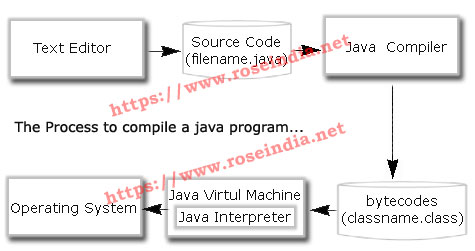To commence with Java programming, we must know the significance of Java Compiler.

Java Compiler
In this tutorial we are going to tell you about the Java Compiler which is used to compile the Java program into byte code. The Java program (.java) file is checked for syntax error and then compiled into class file (.class) which can be interpreted and converted into the machine language in runtime. The Java interpreter is used to convert .class file into machine language on the host machine where it is executed.
To commence with Java programming, we must know the significance of Java Compiler. When we write any program in a text editor like Notepad, we use Java compiler to compile it. A Java Compiler javac is a computer program or set of programs which translates java source code into java byte code.
The output from a Java compiler comes in the form of Java class files (with .class extension). The java source code contained in files end with the .java extension. The file name must be the same as the class name, as classname.java. When the javac compiles the source file defined in a .java files, it generates bytecode for the java source file and saves in a class file with a .class extension.
The most commonly used Java compiler is javac, included in JDK from Sun Microsystems.
Following figure shows the working of the Java
compiler:

Once the byte code is generated it can be run on any platform using Java Interpreter (JVM). It interprets byte code (.class file) and converts into machine specific binary code. Then JVM runs the binary code on the host machine.
How to use Java Compiler
When you run javac command on the command prompt, it shows the following output.
C:\>javac
Usage: javac <options> <source files>
where possible options include:
-g Generate all debugging info
-g:none Generate no debugging info
-g:{lines,vars,source} Generate only some debugging info
-nowarn Generate no warnings
-verbose Output messages about what the compiler is doing
-deprecation Output source locations where deprecated APIs are
|
Above output shows the different options of javac tool.
Using java compiler to compile java file:
Following example shows how a Compiler works. It compiles the program and
gives the Syntax error, if there is any. Like in this example, we haven't
initialized 'a' and we are using it in the next statement as 'int c=a+b'. That
is why its showing a syntax error.
| class A{ public static void main(String[] args){ int a; int b=2; int c=a+b; System.out.println(c); } } |
Output of program:
| C:\Program Files\Java\jdk1.6.0_01\bin>javac A.java A.java:6: variable a might not have been initialized int c=a+b; ^ 1 error C:\Program Files\Java\jdk1.6.0_01\bin> |
Now, lets tweak this example. In this we have initialized 'a' as 'int a =2'. Hence, no syntax error has been detected.
| class A{ public static void main(String[] args) { int a=2; int b=2; int c=a+b; System.out.println(c); } } |
Output of program:
|
C:\Program Files\Java\jdk1.6.0_01\bin>javac A.java C:\Program Files\Java\jdk1.6.0_01\bin>java A 4 |



